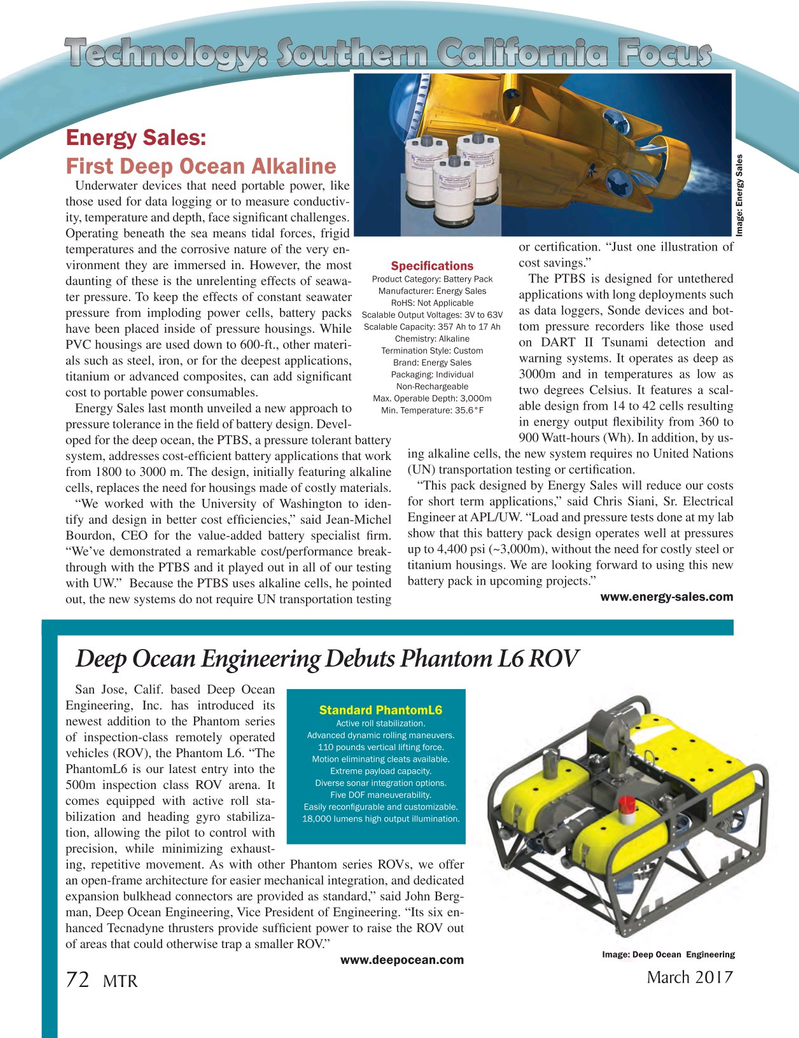
Page 72: of Marine Technology Magazine (March 2017)
Oceanographic Instrumentation: Measurement, Process & Analysis
Read this page in Pdf, Flash or Html5 edition of March 2017 Marine Technology Magazine
Energy Sales:
First Deep Ocean Alkaline
Underwater devices that need portable power, like those used for data logging or to measure conductiv- ity, temperature and depth, face signi? cant challenges.
Image: Energy Sales
Operating beneath the sea means tidal forces, frigid or certi? cation. “Just one illustration of temperatures and the corrosive nature of the very en- cost savings.” vironment they are immersed in. However, the most Speci? cations
Product Category: Battery Pack
The PTBS is designed for untethered daunting of these is the unrelenting effects of seawa-
Manufacturer: Energy Sales applications with long deployments such ter pressure. To keep the effects of constant seawater
RoHS: Not Applicable as data loggers, Sonde devices and bot- pressure from imploding power cells, battery packs
Scalable Output Voltages: 3V to 63V
Scalable Capacity: 357 Ah to 17 Ah tom pressure recorders like those used have been placed inside of pressure housings. While
Chemistry: Alkaline on DART II Tsunami detection and
PVC housings are used down to 600-ft., other materi-
Termination Style: Custom warning systems. It operates as deep as als such as steel, iron, or for the deepest applications,
Brand: Energy Sales
Packaging: Individual 3000m and in temperatures as low as titanium or advanced composites, can add signi? cant
Non-Rechargeable two degrees Celsius. It features a scal- cost to portable power consumables.
Max. Operable Depth: 3,000m able design from 14 to 42 cells resulting
Energy Sales last month unveiled a new approach to
Min. Temperature: 35.6°F in energy output ? exibility from 360 to pressure tolerance in the ? eld of battery design. Devel- 900 Watt-hours (Wh). In addition, by us- oped for the deep ocean, the PTBS, a pressure tolerant battery system, addresses cost-ef? cient battery applications that work ing alkaline cells, the new system requires no United Nations from 1800 to 3000 m. The design, initially featuring alkaline (UN) transportation testing or certi? cation.
“This pack designed by Energy Sales will reduce our costs cells, replaces the need for housings made of costly materials.
for short term applications,” said Chris Siani, Sr. Electrical “We worked with the University of Washington to iden- tify and design in better cost ef? ciencies,” said Jean-Michel Engineer at APL/UW. “Load and pressure tests done at my lab
Bourdon, CEO for the value-added battery specialist ? rm. show that this battery pack design operates well at pressures up to 4,400 psi (~3,000m), without the need for costly steel or “We’ve demonstrated a remarkable cost/performance break- through with the PTBS and it played out in all of our testing titanium housings. We are looking forward to using this new with UW.” Because the PTBS uses alkaline cells, he pointed battery pack in upcoming projects.” www.energy-sales.com out, the new systems do not require UN transportation testing
Deep Ocean Engineering Debuts Phantom L6 ROV
San Jose, Calif. based Deep Ocean
Engineering, Inc. has introduced its
Standard PhantomL6 newest addition to the Phantom series
Active roll stabilization.
Advanced dynamic rolling maneuvers.
of inspection-class remotely operated 110 pounds vertical lifting force.
vehicles (ROV), the Phantom L6. “The
Motion eliminating cleats available.
PhantomL6 is our latest entry into the
Extreme payload capacity.
Diverse sonar integration options. 500m inspection class ROV arena. It
Five DOF maneuverability. comes equipped with active roll sta-
Easily recon? gurable and customizable. bilization and heading gyro stabiliza- 18,000 lumens high output illumination.
tion, allowing the pilot to control with precision, while minimizing exhaust- ing, repetitive movement. As with other Phantom series ROVs, we offer an open-frame architecture for easier mechanical integration, and dedicated expansion bulkhead connectors are provided as standard,” said John Berg- man, Deep Ocean Engineering, Vice President of Engineering. “Its six en- hanced Tecnadyne thrusters provide suf? cient power to raise the ROV out of areas that could otherwise trap a smaller ROV.”
Image: Deep Ocean Engineering www.deepocean.com
March 2017 72
MTR
MTR #2 (66-80).indd 72 MTR #2 (66-80).indd 72 3/1/2017 10:54:28 AM3/1/2017 10:54:28 AM

 71
71

 73
73
